
Electronic english version since 2022 |
The newspaper was founded in November 1957
| |
Personal dimension
Interesting projects, outstanding staff, unique city
The guest of the column is a junior researcher at the Frank Laboratory of Neutron Physics Maxim PODLESNYY.
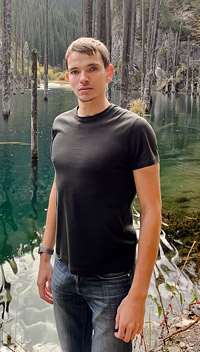 He was born in our city, graduated with a gold medal from the Dubna Lyceum, in 2011-2013, he became a three-time winner of the All-Russian Olympiad for Schoolchildren in Physics and entered the Moscow Institute of Physics and Technology at the Department of General and Applied Physics. In 2019, Maxim graduated with honors from MIPT's master's programme and continued his studies in graduate school. Last year, under the supervision of Head of the Department of Spectrometers Complex of IBR-2 Viktor Bodnarchuk, he defended his thesis "Development and construction of wide-aperture neutron detectors based on the scintillator 6LiF/ZnS(Ag) for time-of-flight spectrometers". While still a student, Maxim began developing thermal neutron detectors. On the pages of the weekly he will talk about how eight years of such productive scientific activity have passed, about research work and the prospects for the developed techniques and systems.
He was born in our city, graduated with a gold medal from the Dubna Lyceum, in 2011-2013, he became a three-time winner of the All-Russian Olympiad for Schoolchildren in Physics and entered the Moscow Institute of Physics and Technology at the Department of General and Applied Physics. In 2019, Maxim graduated with honors from MIPT's master's programme and continued his studies in graduate school. Last year, under the supervision of Head of the Department of Spectrometers Complex of IBR-2 Viktor Bodnarchuk, he defended his thesis "Development and construction of wide-aperture neutron detectors based on the scintillator 6LiF/ZnS(Ag) for time-of-flight spectrometers". While still a student, Maxim began developing thermal neutron detectors. On the pages of the weekly he will talk about how eight years of such productive scientific activity have passed, about research work and the prospects for the developed techniques and systems.
My activities at FLNP JINR started in 2016. Under the supervision of Vladimir Kruglov, I participated in the development of thermal neutron detectors using the 6LiF/ZnS(Ag) scintillator. Such detectors have low gamma sensitivity (10-6) and good thermal neutron conversion efficiency even at thicknesses less than 0.5 mm that is extremely important for spectrometers with high resolution (Δd/d ~ 0.001).
 |
| ASTRA-M detector |
As part of the bachelor's thesis, specialized neutron counters were developed to study the properties of neutron signals. A technique is proposed for determining the depth of neutron interaction in a scintillator using a counter with individual collection of light from each surface of the scintillator based on the signal amplitude ratio. However, the technique itself has limitations in its applicability for 6LiF/ZnS(Ag) scintillators due to their low transparency.
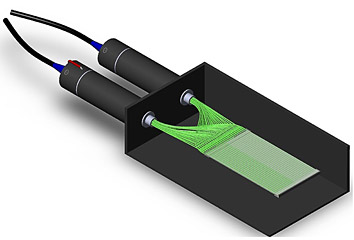 |
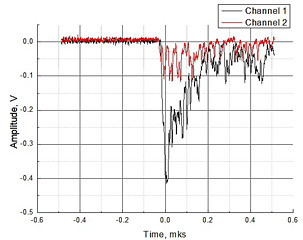 |
| Neutron counter using optical fibers separated from different surfaces to a separate photomultiplier | Neutron signal observed from two photomultipliers from one neutron event. From the ratio of the signal amplitudes, the scintillation depth can be determined |
My master's thesis was dedicated to the investigation of the shape of neutron signals particular to scintillation counters with low light collection efficiency. First of all, the formation of these shapes is due to the low efficiency of fiber light guides with a spectrum re-emitter, since the fraction of light re-emitted at angles of total internal reflection is less than 10% even for multilayer fibers. Due to the long afterglow typical for the ZnS(Ag) scintillator and the complex shape of the signals, to work with these signals it is necessary to introduce a dead time of the order of several microseconds. Therefore, at high loads of one registering channel, the standard technique with signal discrimination by its duration and non-extendable dead time is inefficient. Our group has proposed a charge technique for processing PSD (Pulse shape discrimination) signals that is a measurement of charges accumulated over two periods of time after the amplitude discriminator is triggered. At high loads, it is possible for more than one neutron to hit within the given time windows. If these events are isolated, it becomes possible to increase the neutron count.
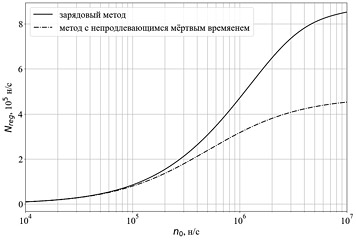 |
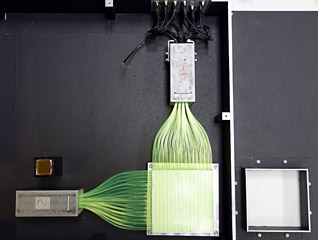 |
| Dependence of the neutron count for the PSD technique and the technique with non-extendable dead time on the neutron flux intensity | Assembled two-dimensional detector |
High loading simulations were carried out by superimposing neutron signals using the Monte Carlo method according to a Poisson distribution for neutron event rates of 106 n/c. The research was carried out using real neutron signals registered from an experimental stand. It is shown that this technique at an intensity of 106 n/c well registers the fact of the second neutron ingression ~ 80%).
Later, experimental comparative research of the PSD technique with the signal duration filter technique was carried out using a neutron generator and one counter of the ASTRA-M detector. The result of the research showed a twofold increase in the efficiency of neutron signal extraction when loading one registration channel of the order of 3x104 n/c. The research is relevant, since the calculated peak load of one registration channel on the ASTRA-M detector using a Fourier chopper is 7.18x104 n/c and on the BSD (backscattering detector) - 2.17x105 n/c. Thus, the proposed technique allowed to significantly increase the efficiency of neutron signal extraction for the developed detectors.
My main activity during my graduate studies was dedicated to the development and construction of a wide-aperture backscattering detector for the IBR-2 high-resolution Fourier diffractometer based on the scintillator 6LiF/ZnS(Ag) using developed techniques. The detector has a ring structure, contains 6 ring assemblies covering the scattering angle areas 2θ = (133-175)°, the complete solid angle of the detector is 2 steradians. The average thermal neutron conversion efficiency (1.8 A) is 85% for two scintillator layers. To calculate the main parameters, I developed a set of programmes written in the Wolfram Language programming language in the Mathematica system. And here I wish to thank my friend from MIPT Alexander Kazantsev, Master of Mathematica that helped to implement complex algorithms. The programme allows you to calculate the detector geometry, thermal neutron conversion efficiency, as well as the contribution to the geometric component of the spectrometer resolution function using the Monte Carlo method.
At present, the backscattering detector is in the final stage of assembly. Its configuration, as well as its commissioning is scheduled with putting the IBR-2 reactor into operation.
At the same time, a prototype of a two-dimensional position-sensitive detector was developed based on the 6LiF/ZnS(Ag) scintillator using wavelength-shifting optical fibers of square cross-section. The size of the detecting surface is 96x96 cm2, corresponds to 16 registration channels along the X axis and 16 channels along the Y axis. The detector design includes four layers of scintillator, between which light guides are positioned. Unfortunately, the low transparency of scintillation screens to their own radiation does not allow illumination of fibers on both sides of the scintillator (the optimal scintillator thickness should be 0.25 mm when 0.42 mm was used), so the detector efficiency was 8% with 80% conversion efficiency. Nevertheless, the techniques mastered and the experience gained will allow to develop large-area two-dimensional detectors in the future.
Since September 2020, I have been taking part in the NEPTUNE pulsed reactor project. The main work consists of implementing analytical and numerical thermomechanical calculations of temperature fields in fuel elements; mechanical deformations of various fuel rod designs are studied.
Research reactors are characterized by compact cores and relatively thick fuel rods. Due to the unevenness of the neutron flux in the reactor core, there is a noticeable gradient in the energy release and consequently, in the temperature in the fuel rod core and in its steel shell in the radial direction to the centre of the core. The consequence of the temperature gradient is the bending of the tablets and the shell.
To determine the temperature fields, analytical and numerical thermophysical calculations were carried out. The resulting fields were loaded into the ANSYS prototype in terms of initial conditions, with the help of which research of mechanical deformations of various fuel rod designs was carried out. Among the important results, I would like to highlight the detection of dynamic bending of fuel rods - beatings caused by their own oscillation modes and the frequency of the external disturbing force (reactor power pulses). The fastening of the fuel rod directly affects both the natural vibration modes and their amplitude, as well as the direction of displacement of the fuel rods. This effect plays a significant role in estimating the stable operation of pulsed reactors.
In 2023, I proposed and my colleagues supported me, a prototype for calculating temperature fields in fuel assemblies (FA) that allows us to estimate the temperature difference of the walls of the fuel assembly, as well as to obtain the value of the efficient thermal diffusivity for the fuel assembly. The next stage will be to clarify the development of this prototype and to build a prototype of the dynamics of the NEPTUNE reactor, as well as the development and construction of specialized stands for carrying out experiments to verify the resulting prototype.

***
During my student years, I came to JINR spontaneously. To be more precise, when entering MIPT, I chose the department at JINR primarily because of its geographical location. My scientific interests were not developed at that moment; I just loved meeting tasks in physics, mathematics and computer science. I wanted to get a decent education and decide on my future plans during the learning process. And the moment when I could already say that I consciously chose to work at JINR was the defense of my PhD thesis. And this time, due to the interesting projects, in the case of the NEPTUNE project, I would add unique ones. Among the advantages, I would also note the outstanding staff, both in scientific achievements and in personal qualities. A unique city that suits my lifestyle perfectly. I am interested in football, tennis, table tennis, skiing, alpine skiing and playing chess. I ran two running marathons and two skiing marathons and I compete for JINR at the amateur sports team and at city competitions. It's possible to unite all this because the city and the Institute have the appropriate infrastructure, so there's no need to waste time on the road. In addition, I am a lover of board games and good company. In this regard, our AYSS is the best!
Based on the information from the JINR Press Office